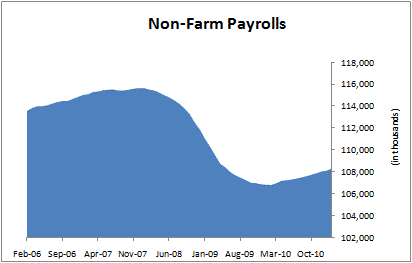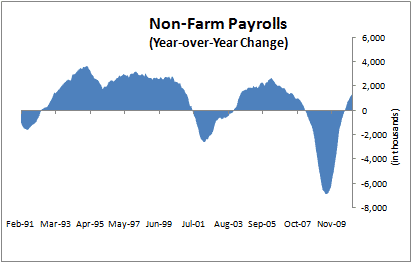More on The Employment Situation Summary, February 2011
Here are a few bullet points that outline some of the major takeaways from this job report. I have put them in pro versus con format, with pro being good data and con being bad data.
PRO
- The headline numbers of 8.9% unemployment and 15.9 underemployment were good.
- Revisions are usually upward at this point in the business cycle. If you look at things like the birth-death adjustment which are used to measure new business contribution to job growth, we know that the models underestimate the number of new businesses added. We should expect upward revisions to these numbers. Translation: the numbers are probably more robust than reported.
- The change in unemployed is down significantly. The number of unemployed in the household survey (numbers which are not revised) topped out at 15.6 million in October 2009. We now have 13.7 million unemployed. Both numbers are seasonally adjusted.
- The year-over-year change in the unemployment rate is down 0.8%. That is the best figure since April 1998. This number which is a good coincident indicator of cycle turning points topped out at an increase of 4.0% in June 2009. All numbers are seasonally adjusted. Bottom line: we are nowhere near double dip right now.
- The year-over-year change in non-farm payrolls is way up. We have 1.27 million more jobs than at this time last year. This is another coincident indicator of cycle shifts as the number bottomed at a loss of 6.82 million jobs in June 2009 when the statistical recovery began.
CON
- The labor participation rate is still declining. The seasonally-adjusted rate confirmed January’s cycle low of 64.2%, the lowest rate since March 1984. In a recovery, this rate should be increasing as discouraged workers not in the labor force re-enter to look for employment.
- The number of persons not in the labor force reached a high of a seasonally-adjusted 85.6 million, while those who want a job increased to 6.4 million. These numbers should rise with the population. However, when the employment situation improves in a recovery, they drop, as they did from 1983-1990 and in 1994 and 2004.
- Hourly earnings are not increasing enough in the face of rising food and energy prices. Not only did hourly earnings not rise in this report but hours worked also did not rise. While tax cuts will help out here, if oil prices keep rising consumption demand will be diverted to food and energy, leading to an increased trade deficit. Note: because the price deflator for GDP does not include imported prices, you should not expect GDP to necessarily be impacted by the increase in inflation.
Those are the big hits that I saw. Below are two charts on non-farm payrolls.


With stagnant hourly earnings and increasing inflation in core food and energy expect living standards to fall. Until there is an improvement in real disposable incomes the US will be marginalising a larger population every year.
With stagnant hourly earnings and increasing inflation in core food and energy expect living standards to fall. Until there is an improvement in real disposable incomes the US will be marginalising a larger population every year.